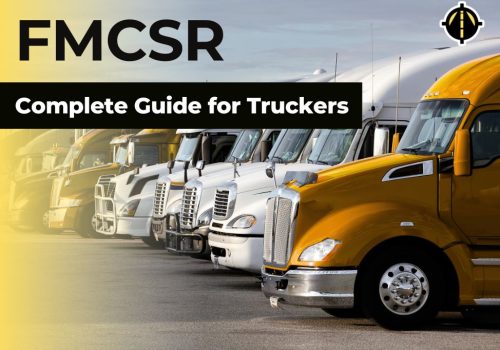The trucking industry plays a pivotal role in the transportation of goods throughout the nation and our neighboring countries, carrying an estimated 70 to 80% of the United States’ freight. In fact, a staggering 11.9 billion tons of freight are transported annually by these industry stalwarts, encompassing a vast array of consumer goods such as food, cars, raw materials, and oil. As the American Trucking Association succinctly puts it, virtually every product in the United States has, at some point in its journey, been transported on a truck.
Let’s take a look at what the trucking industry has done over the last few years and where it’s headed.
General Trucking Industry Statistics
- The trucking industry moves nearly 12 billion tons of freight worth $772B
- 67% of goods moved between the U.S. and Canada, and 83% with Mexico is transported by trucks.
- 72% of all freight transported in the U.S. is hauled by trucks.
- Most carrier companies are small businesses with 97.4% of their work with less than 20 trucks
- 91% of them operate with 6 or fewer trucks.
- The trucking industry employs approximately 7.95 million workers
- of which 3.6 million are professional truck drivers.
- The covid-19 pandemic brought about a 3.3% loss in the annual revenue earned by the trucking industry in 2020. The business surged in mid-2021.
- The trucking industry is expected to grow by 21% by 2031.
- The top 3 materials transported by trucks are food, machinery, and electronics.
*Source: American Trucking Association
Liabilities, Accidents and Fleet Driver Safety Statistics
A person who drives more on average increases their risk of having an accident. Over the years, the industry has seen an increase in crashes leading to fatalities. These types of accidents usually occur from distracted driving and other driver behaviors, as well as other drivers not knowing how to interact with a semi on the road. Trucking companies have also started to see an increase in insurance premiums due to these accidents. Companies are starting to take driver safety more seriously due to these factors.
- In 2018, 4,136 people died in large truck crashes.
- 11% of all motor vehicle crash deaths that occurred in 2018 involved large trucks.
- In 2018, 74% of large truck crashes involved tractor-trailers.
- 27% of large truck crashes involved a single-unit truck in 2018.
- 52% of crash deaths involving large trucks occurred on major roads.
- 33% of crash deaths involving large trucks occurred on freeways and interstates.
The average cost of loss related to a fleet vehicle accident is $70,000.
Insurance premiums for trucking companies have seen a huge spike in the last few years. To be sure that you have the best deal on business insurance, we recommend getting quotes from independent insurance brokers!
*Source: U.S Department of Transportation, NU Property Casualty 360, Automotive Fleet
Economics and Trucking Industry Data
Employment Demographics and Compensation
While the trucking industry is primarily a male-dominant workforce, there was only about a two percent increase in the number of women employed in the last 18 years, and recruiting female drivers is a problem the industry continues to face. It is, however, a racially diverse industry. The industry’s average median salary is not very competitive compared to other sectors, which may contribute to the high turnover rate and difficulty in recruiting drivers.
In 2019, there were 3.6 million truck drivers employed in the U.S.
- 7.95 million people were employed in trucking-related jobs in the U.S.
- 6.7% of the truck drivers in the U.S are women.
- 41.5% of the trucking industry drivers are minorities.
- The average age of drivers in the trucking industry is 46 years old.
- The average annual wage for heavy and tractor-trailer truck drivers is $46,370
- but can exceed $250,000 for owner-operators and small fleet owners
- The average annual salary for light or delivery service truck drivers is $41,960.
- In July 2020, the average hourly earnings for employees in the industry was $26.30.
- The average industry employee worked 41.2 hours per week in July 2020.
*Source: American Trucking Association and U.S. Bureau of Labor Statistics
Statistics on Driver Shortages
Freight is on the rise, and the trucking industry needs more truck drivers to manage. One of the leading problems the industry is currently facing is the shortage of truck drivers. According to the American Trucking Association, the industry has been struggling with this problem on and off since 2015. One of the leading causes keeping the driver shortage high is the high average age of the current workforce.
The industry is struggling to replace retirees and new drivers have a high turnover. More companies are cracking down on safety prioritization and are having trouble finding qualified drivers.
In 2018, the trucking industry was short 60,800 drivers, which was a record high and up 20 percent from the previous year.
In 2019, it was expected that the average shortage of drivers would decrease to 59,500.
Employment for truck drivers was projected to grow by only 2 percent from 2019 to 2029.
There has been a 38% drop in driver job posting activity from 2019 to 2020; trucking job posting online is shown to be ineffective.
*Source: American Trucking Association and U.S. Bureau of Labor Statistics
According to the ATA, the industry will need to hire about 1.1 million new drivers for the next decade or an average of 110,000 drivers per year to combat the driver shortage. The largest factor contributing to the driver shortage is retiring truck drivers who will need to be replaced with new hires, which will account for 54% of new driver hires.
The decline in Trucking Industry Earnings and Revenue
Truckload carriers’ revenue will suffer in 2023 due to decreasing economic activity and contractual-rate decline. The revenues will also bear the brunt of increasing insurance prices, high maintenance costs, and increasing labor. High equipment cost is also a major issue.
The trucking industry has no other way but to keep the equipment because of a decrease in new supply. As the demand for used equipment declines the equipment sale will become a challenging problem in 2023. In 2022 EPS was higher than the last year but the earnings are expected to fall 14% in 2023.

Freight Brokerage Layoffs
The trucking industry has experienced recent mass job cuts. This happened suddenly and supposedly during a time when all metrics were pointing to a driver shortage! Freight brokerage companies laid off almost 1000 employees in early 2023, while last year the number was 700. The main reason behind the job crisis is again Covid-19 and its effect on the trucking industry.
Initially, the sales dropped dramatically in June 2020 because of low consumer demand as expected. The decline in sales continued throughout 2020 and most of 2021 but started rising slowly at the end of 2021.
The increasing demand meant more freight transportation. After the covid crisis started to wane people began to use their money for exercise equipment and other heavy material. This translated into a surge of shipments and a burden on the trucking industry. The shippers had to go to an intermediary or freight brokerage company.
The freight brokers gained a lot of money and their net income rose by 66.7% in 2021 in comparison with last year. Now as their work increases freight brokers had to employ a new workforce to meet the demand. It called for “crisis hiring” as described by Poliniak-Cusic.
As consumer demand crashed to normal in 2022 the need for extra workforce also declined dramatically. This led to layoffs in freight broker companies and economical inflation.
The Future of Trucking

San Diego-based company TuSimple has already started testing their self-driving trucks and predicts these trucks will not only have a positive impact on the industry but the environment as well. TuSimple says its technology is aimed at transforming the trucking industry by reducing carbon emissions, lowering costs, and increasing safety. Even they had a 50% layoff in some departments in December!
Despite current headwinds, by 2025, the global self-driving truck market is expected to reach $1,699 million.
The compound annual growth rate for the autonomous truck industry is expected to reach 18.6% by 2025.
A survey found that more than half of small businesses believe fleets will be completely autonomous in 20 years.
The same survey found that 37% of small business owners believe that fleets could go fully autonomous in as little as 10 years.
In a study conducted by TuSimple, they found that their self-driving trucks were 10% more fuel-efficient than traditional trucks.
TuSimple says applying their self-driving technology can help save about 42 million metric tons of CO2 emissions per year.
Applying TuSimple’s technology to all diesel trucks could result in saving 4 billion gallons of fuel with a cost savings of $10 billion per year.
Though the trucking industry has gone through major shifts in recent years, it still remains one of the nation’s most profitable sectors. Self-driving trucks could be the future of the trucking industry and help solve the current problems it faces. New technology can seem scary to an industry that’s been doing well for years, but embracing this change can create a safer industry and contribute to a safer environment overall.
Trucking Industry Forecast
According to the American Trucking Association’s U.S. Freight Transportation Forecast to 2022, the U.S. is likely to see a 24 percent increase in freight tonnage in 2022. The good news is that revenue is predicted to increase by 67 percent as a result, and most of those gains will occur within the trucking industry.
Because of the decline that the industry experienced during 2019, many believe that the industry is likely to turn around and experience a gradual increase as a result of the new developments that are coming to this industry. A market flip is expected to emerge in 2022 and is one factor that can help save the several companies that are likely to go under unless the current conditions within the market improve. One report says the only way to slow down the freight market and stabilize freight prices would be to ensure a steady stream of capable commercial drivers.











 Answer 5 simple questions to request a
Answer 5 simple questions to request a